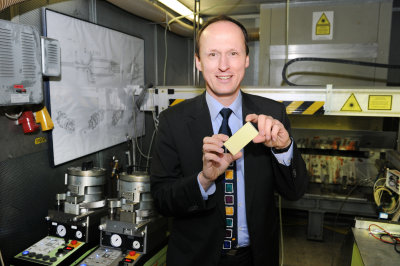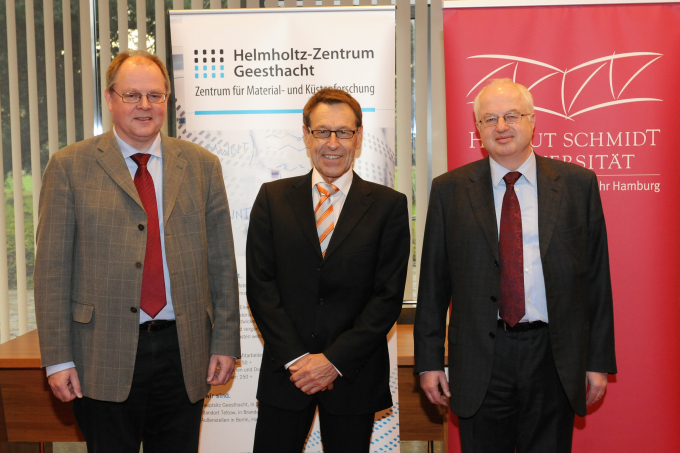The Helmholtz Centre Geesthacht and the Helmut Schmidt University agree upon close cooperation
On Friday 9th December 2011, the president of the Helmut Schmidt University (HSU) Prof. Dr. Wilfried Seidel and the directors of the Helmholtz Centre Geesthacht (HZG), Prof. Dr. Wolfgang Kaysser and Michael Ganß, signed a cooperation agreement to link fields of research in which their two establishments are at the forefront worldwide. The object of the agreement is the creation and sharing of resources for materials research.

The titanium dioxide coating is applied by means of cold gas spraying, whereby significantly more hydrogen is produced than with conventional methods Photo: HZG
The focus of research in the Institute of Materials Technology at the Helmut Schmidt University is Surface Technology. The institute leads the world in the field of cold gas spraying. A significant role has been played at the HSU in the development of this relatively new coating technique, which enables the production of functional surfaces for a wide range of application areas.
Cold gas spraying is a process in which the coating material is applied to a substrate, in powder form, at a very high velocity. In order to achieve this, a comparatively moderately heated process gas is accelerated to supersonic speed through expansion in a nozzle. The powder particles are then injected into the gas beam and are thereby accelerated to such a high velocity that they, in contrast to conventional thermal spraying processes, form a dense and firmly bonding coating on impact, without prior melting or smelting.
As Professor Dr. Thomas Klassen, director of the Institute of Materials Technology at the HSU and also head of the Materials Technology division at the HZG, explains: “Cold gas spraying can be used to coat components - such as solar cells, for example – and thus create surfaces which are so active that they can produce significantly more hydrogen than conventional reactors. The Helmholtz Centre in Geesthacht is already playing a leading role worldwide in the field of hydrogen storage in metal hydrides and in the development of innovative membranes for gas separation and fuel cells.
More research into new components

The Helmholtz directors Michael Ganß and Wolfgang Kaysser with the president of the HSU Wilfried Seidel (from left to right.), after signing the agreement creating strong links between their research activities. Photo: HZG
The bundling of the departments of “Nanotechnology” and “Membranes for Regenerative Energy Technology” in the “Materials Technology” division of the Institute of Materials Research at the HZG offers a unique opportunity to unite the complementary expertise of these departments and align future research activities to system solutions.
According to Prof. Dr. Wolfgang Kaysser, Scientific Director of the Helmholtz Centre Geesthacht: “The cost effective mass production of hydrogen from regenerative sources calls for the development of effective methods to separate and process hydrogen with minimal energy consumption.“
The collaboration between the two institutions opens up new prospects for focused research in the fields of regenerative energy technology and the conservation of resources, in particular in the field of hydrogen technology.
During the first five-year term of the cooperation agreement, Prof. Dr. Thomas Klassen will serve as professor at the HSU and concurrently as director of the HZG. His remuneration will be paid equally by the two establishments. In addition, a junior professorship will be jointly established by the HSU and the HZG which will also direct itself towards functional materials for regenerative energy technology. Research is to be carried out on the outstanding cold gas sprayed coatings of photocatalytic active, nanocrystalline titanium dioxide, with particular regard to the production of hydrogen by means of solar energy.
This topic offers a wide variety of development possibilities, both in basic and applied research. On the one hand, catalytic reactions are critical process in hydrogen storage and in fuel cells. On the other hand, photocatalytic coatings also have the potential for other reactions e.g. degradation of harmful substances in water or in the air.
The cooperation agreement also relates to academic teaching at the HSU. Appropriately qualified employees of the Helmholtz Centre Geesthacht can take up lectureships at the Department of Mechanical Engineering at the HSU, as and when required. In return, the Helmholtz Centre Geesthacht will allow students of the Helmut Schmidt University to carry out their studies and thesis programmes at the HZG.
More Information
Werkstofftechnologie Helmut-Schmidt-UniversitätContact

Max-Planck-Straße 1
21502 Geesthacht
